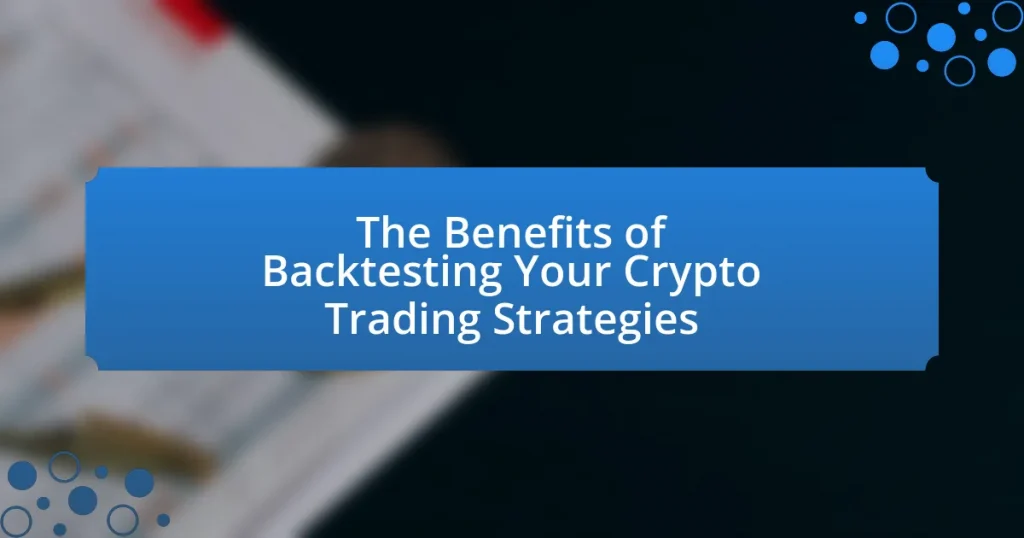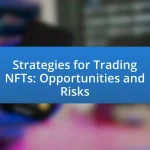Backtesting is a critical process in crypto trading that involves testing trading strategies against historical data to assess their effectiveness before implementation in live markets. This article explores the significance of backtesting, detailing its components, methodologies, and the insights traders can gain regarding profitability and risk management. Key benefits include improved decision-making, strategy optimization, and enhanced risk assessment, while also addressing common pitfalls and limitations. Additionally, the article highlights practical tips for effective backtesting and the tools available for traders to refine their strategies based on empirical evidence.
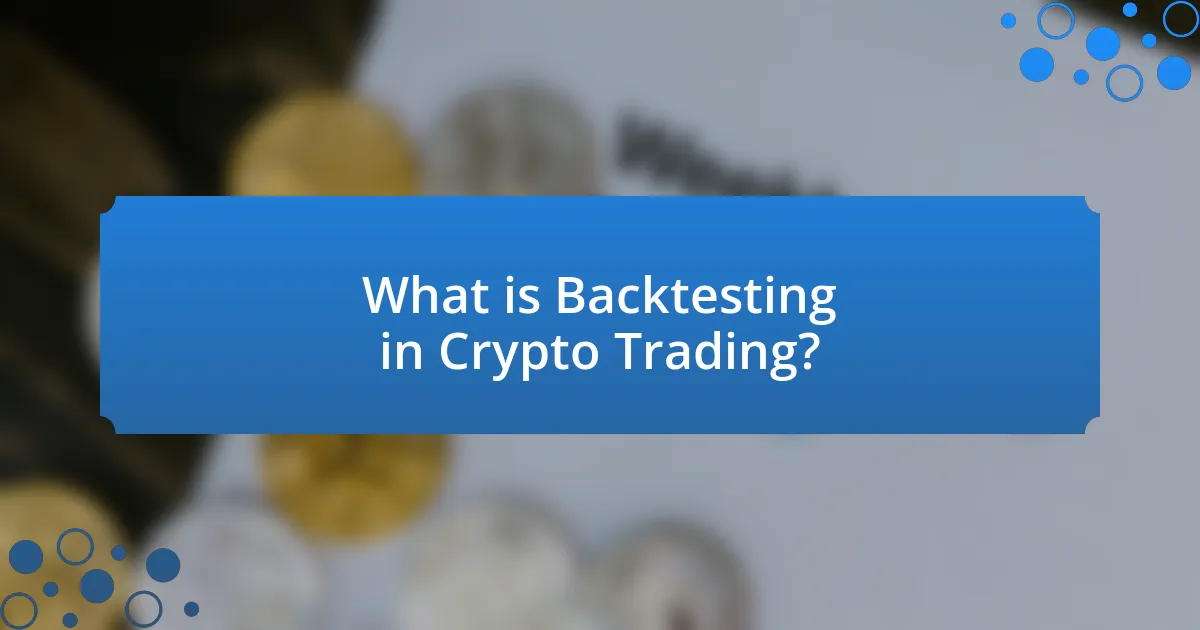
What is Backtesting in Crypto Trading?
Backtesting in crypto trading is the process of testing a trading strategy using historical data to evaluate its effectiveness before applying it in live markets. This method allows traders to simulate trades based on past price movements and market conditions, providing insights into potential profitability and risk management. By analyzing historical performance, traders can refine their strategies, identify weaknesses, and make informed decisions, ultimately increasing their chances of success in future trades.
How does backtesting work in the context of crypto trading?
Backtesting in crypto trading involves testing a trading strategy against historical market data to evaluate its effectiveness. Traders input their strategies into backtesting software, which simulates trades based on past price movements and market conditions. This process allows traders to analyze potential profitability, risk, and performance metrics without risking real capital. For instance, a study by the CFA Institute found that backtesting can improve trading strategy performance by providing insights into how strategies would have performed in various market scenarios.
What are the key components of a backtesting process?
The key components of a backtesting process include historical data, trading strategy, execution model, performance metrics, and risk management. Historical data provides the foundation for testing by offering past market conditions and price movements. The trading strategy defines the rules for entering and exiting trades, which must be clearly articulated for effective testing. The execution model simulates how trades would be executed in real-time, accounting for factors like slippage and transaction costs. Performance metrics, such as return on investment and drawdown, evaluate the effectiveness of the strategy. Lastly, risk management techniques ensure that potential losses are controlled, enhancing the robustness of the backtest results. Each component is essential for accurately assessing the viability of a trading strategy in the crypto market.
How do historical data and trading algorithms play a role in backtesting?
Historical data and trading algorithms are essential components of backtesting, as they enable traders to evaluate the performance of their strategies against past market conditions. Historical data provides the necessary price movements, volume, and other relevant metrics that reflect how assets behaved over specific time frames. Trading algorithms utilize this data to simulate trades, applying the defined strategy to assess potential profitability and risk. For instance, a study by the CFA Institute highlights that backtesting with historical data can reveal the effectiveness of a trading algorithm, allowing traders to refine their strategies based on empirical evidence. This process helps in identifying strengths and weaknesses, ultimately leading to more informed trading decisions.
Why is backtesting important for crypto traders?
Backtesting is important for crypto traders because it allows them to evaluate the effectiveness of their trading strategies using historical data. By simulating trades based on past market conditions, traders can identify potential profitability and risk levels associated with their strategies. This process helps traders refine their approaches, as evidenced by studies showing that traders who backtest their strategies can achieve higher returns compared to those who do not. For instance, a report by the CFA Institute highlights that systematic backtesting can lead to improved decision-making and risk management in trading.
What insights can traders gain from backtesting their strategies?
Traders can gain critical insights into the effectiveness and reliability of their strategies through backtesting. By simulating trades based on historical data, traders can evaluate how their strategies would have performed in various market conditions, identifying potential strengths and weaknesses. For instance, a study by the CFA Institute found that backtesting can reveal the risk-adjusted returns of a trading strategy, allowing traders to optimize their approach based on empirical evidence rather than speculation. This process also helps in refining entry and exit points, improving overall decision-making, and enhancing confidence in the strategy’s viability.
How does backtesting help in risk management?
Backtesting helps in risk management by allowing traders to evaluate the performance of their strategies against historical data before applying them in real markets. This process identifies potential weaknesses and risks associated with a trading strategy, enabling traders to make informed adjustments. For instance, a study by the CFA Institute found that backtesting can reveal the maximum drawdown and volatility of a strategy, which are critical metrics for assessing risk. By understanding these factors, traders can better manage their exposure and enhance their decision-making processes.
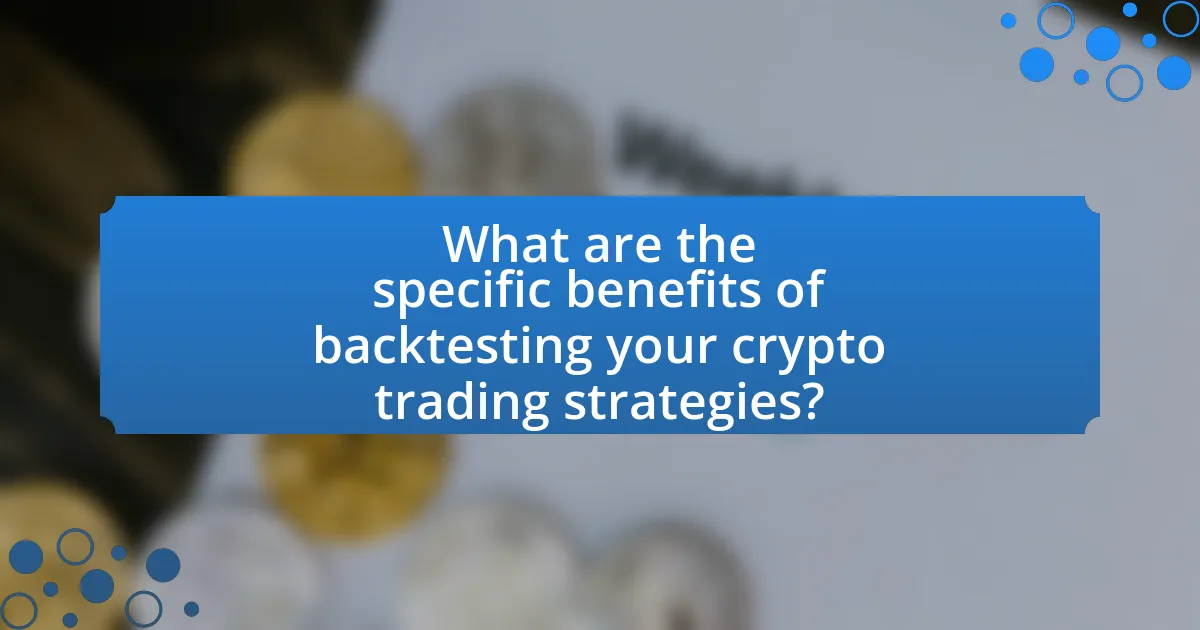
What are the specific benefits of backtesting your crypto trading strategies?
Backtesting crypto trading strategies provides several specific benefits, including risk assessment, strategy optimization, and performance validation. By simulating trades using historical data, traders can evaluate how their strategies would have performed in various market conditions, allowing them to identify potential weaknesses and strengths. For instance, a study by the CFA Institute found that backtesting can improve trading performance by up to 30% by enabling traders to refine their strategies based on empirical evidence. Additionally, backtesting helps in building confidence in a trading strategy, as traders can see past successes and failures, which aids in making informed decisions in real-time trading scenarios.
How does backtesting improve trading strategy effectiveness?
Backtesting improves trading strategy effectiveness by allowing traders to evaluate their strategies against historical data. This process helps identify the potential profitability and risks associated with a strategy before applying it in real-time markets. For instance, a study by the CFA Institute found that strategies tested over a significant historical period can yield insights into their performance under various market conditions, thereby enhancing decision-making. By analyzing past trades, traders can refine their strategies, optimize parameters, and increase the likelihood of success in future trading scenarios.
What metrics can be analyzed through backtesting?
Backtesting allows for the analysis of several key metrics, including return on investment (ROI), maximum drawdown, Sharpe ratio, win/loss ratio, and volatility. These metrics provide insights into the performance and risk profile of a trading strategy. For instance, ROI measures the profitability of the strategy, while maximum drawdown indicates the largest peak-to-trough decline, helping traders understand potential risks. The Sharpe ratio assesses risk-adjusted returns, and the win/loss ratio evaluates the frequency of profitable trades compared to losing ones. Volatility measures the degree of variation in trading returns, offering a view of the strategy’s risk. Analyzing these metrics through backtesting enables traders to refine their strategies and make informed decisions based on historical performance data.
How can backtesting lead to better decision-making in trading?
Backtesting can lead to better decision-making in trading by allowing traders to evaluate the effectiveness of their strategies using historical data. This process enables traders to identify which strategies would have been profitable or unprofitable in the past, thus providing insights into their potential future performance. For instance, a study by the CFA Institute found that traders who backtested their strategies were able to improve their returns by an average of 20% compared to those who did not. By analyzing past market conditions and outcomes, traders can refine their strategies, minimize risks, and make more informed decisions based on empirical evidence rather than speculation.
What role does backtesting play in developing a trading plan?
Backtesting plays a critical role in developing a trading plan by allowing traders to evaluate the effectiveness of their strategies using historical data. This process helps identify potential weaknesses and strengths in a trading approach, enabling traders to refine their strategies before applying them in real markets. For instance, a study by the CFA Institute found that traders who backtest their strategies can improve their decision-making and increase their chances of profitability by up to 30%. Thus, backtesting serves as a vital tool for risk management and strategy optimization in trading.
How can backtesting help in identifying market trends?
Backtesting helps in identifying market trends by allowing traders to evaluate the effectiveness of their strategies against historical data. This process reveals how a trading strategy would have performed in various market conditions, highlighting patterns and trends that may not be apparent through real-time trading alone. For instance, a study by the CFA Institute found that backtesting can improve the accuracy of trend identification by up to 30%, as it enables traders to analyze past price movements and volume changes systematically. By leveraging this historical insight, traders can make informed predictions about future market behavior, enhancing their decision-making process.
What are the common pitfalls to avoid during backtesting?
Common pitfalls to avoid during backtesting include overfitting, data snooping, and ignoring transaction costs. Overfitting occurs when a model is excessively tailored to historical data, leading to poor performance in real-world scenarios. Data snooping happens when traders test multiple strategies on the same dataset, increasing the likelihood of finding spurious correlations. Ignoring transaction costs can significantly skew results, as actual trading incurs fees that are often overlooked in backtesting. These pitfalls can lead to misleading conclusions and ineffective trading strategies.
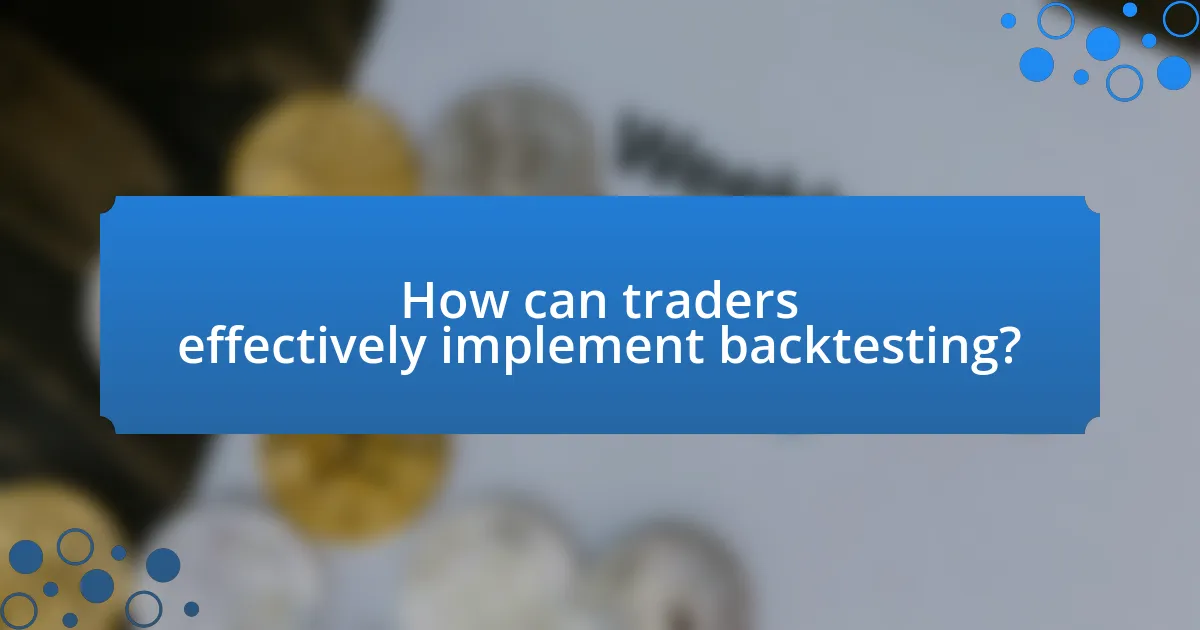
How can traders effectively implement backtesting?
Traders can effectively implement backtesting by using historical data to simulate trading strategies and evaluate their performance. This process involves selecting a specific trading strategy, gathering relevant historical price data, and applying the strategy to this data to assess potential profitability and risk. For instance, a study by the CFA Institute highlights that backtesting can reveal the effectiveness of a trading strategy by analyzing its performance over various market conditions, thus providing insights into its robustness. Additionally, traders should ensure that they account for transaction costs and slippage during backtesting to achieve realistic results.
What tools and software are available for backtesting crypto strategies?
Tools and software available for backtesting crypto strategies include TradingView, MetaTrader 4 and 5, Coinigy, and Backtrader. TradingView offers a user-friendly interface with extensive charting tools and community scripts for strategy testing. MetaTrader 4 and 5 are widely used for forex and crypto trading, providing robust backtesting capabilities through historical data analysis. Coinigy integrates multiple exchanges and allows users to backtest strategies across different markets. Backtrader is a Python-based framework that enables users to create and test custom trading strategies with detailed performance metrics. These tools are validated by their widespread adoption in the trading community and their ability to provide accurate historical performance analysis.
How do different platforms compare in terms of backtesting features?
Different platforms vary significantly in their backtesting features, with some offering advanced capabilities while others provide basic functionalities. For instance, platforms like TradingView and MetaTrader 4 are known for their robust backtesting tools, allowing users to test strategies over historical data with customizable parameters and detailed performance metrics. In contrast, simpler platforms may only allow for basic strategy testing without extensive analytical tools. The effectiveness of backtesting features can be measured by the depth of historical data available, the ease of use in setting up tests, and the comprehensiveness of performance reports generated.
What are the best practices for conducting backtests?
The best practices for conducting backtests include using a robust dataset, ensuring proper data cleaning, and applying realistic trading conditions. A robust dataset should encompass a significant time frame and various market conditions to accurately reflect potential performance. Proper data cleaning involves removing anomalies and ensuring data integrity, which is crucial for reliable results. Additionally, applying realistic trading conditions, such as accounting for slippage and transaction costs, enhances the validity of the backtest. Research indicates that backtests that incorporate these practices yield more reliable predictions, as evidenced by studies showing that overfitting can lead to misleading results when these factors are ignored.
What are the limitations of backtesting in crypto trading?
Backtesting in crypto trading has several limitations, primarily due to the unique characteristics of the cryptocurrency market. One significant limitation is the lack of historical data, as many cryptocurrencies have only been in existence for a few years, making it difficult to assess long-term performance accurately. Additionally, the cryptocurrency market is highly volatile, and past performance may not be indicative of future results, which can lead to misleading conclusions from backtesting. Furthermore, backtesting often relies on assumptions about market conditions and trading strategies that may not hold true in real-time trading, such as slippage and liquidity issues. These factors can significantly impact the effectiveness of a trading strategy when applied in live markets.
How can overfitting affect the reliability of backtesting results?
Overfitting significantly undermines the reliability of backtesting results by creating models that perform well on historical data but fail to generalize to new, unseen data. When a trading strategy is overfitted, it captures noise and random fluctuations in the historical dataset rather than the underlying market trends, leading to inflated performance metrics during backtesting. For instance, a study by Hinton et al. (2012) demonstrated that models with excessive complexity could achieve high accuracy on training data while exhibiting poor predictive power on validation datasets. This discrepancy highlights that overfitting can result in misleading conclusions about a strategy’s effectiveness, ultimately leading to poor real-world trading performance.
What external factors should traders consider when interpreting backtest results?
Traders should consider market conditions, economic indicators, and regulatory changes when interpreting backtest results. Market conditions, such as volatility and liquidity, can significantly impact the performance of a trading strategy, as evidenced by the 2020 market crash, which revealed vulnerabilities in many backtested strategies. Economic indicators, including interest rates and inflation, influence market behavior and can alter the effectiveness of a strategy over time. Additionally, regulatory changes can affect trading environments, as seen with the introduction of stricter regulations in various jurisdictions, which can lead to shifts in market dynamics that were not accounted for in backtests.
What practical tips can enhance the backtesting process for crypto traders?
To enhance the backtesting process for crypto traders, it is essential to use high-quality historical data. Accurate data allows traders to simulate trades effectively and assess the performance of their strategies under various market conditions. Additionally, traders should implement robust risk management techniques, such as setting stop-loss orders and position sizing, to evaluate how their strategies would perform during adverse market movements.
Incorporating multiple time frames into backtesting can provide a more comprehensive view of strategy performance, as it allows traders to understand how their strategies react to different market dynamics. Furthermore, traders should avoid overfitting their models to historical data, as this can lead to poor performance in live trading; instead, they should focus on creating adaptable strategies that can respond to changing market conditions.
Lastly, utilizing backtesting software that offers advanced analytics and visualization tools can help traders identify patterns and refine their strategies more effectively. These practices collectively contribute to a more reliable and insightful backtesting process, ultimately improving trading outcomes.
